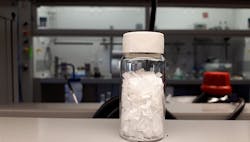Hybrid Catalyst Targets End-Of-Life Plastics
Single-use plastic waste, such as bottles and food containers, can provide ready-to-use molecules for creating jet fuels, diesel and lubricants, thanks to a hybrid catalyst, report researchers at the Center for Plastics Innovation (CPI) at the University of Delaware (UD), Newark, Delaware. Their method uses low temperatures, thus saving two to three times the energy needed and doesn’t emit carbon dioxide (CO2), they say.
“The catalysts can handle various plastics and mixtures and perform almost equally well. We also can regenerate and reuse the catalyst,” notes Dion Vlachos, who led the project and also directs the Delaware Energy Institute and the Catalysis Center for Energy Innovation at UD.
The process, reported in a recent issue of Science Advances, uses a hybrid dual catalyst combining zeolites and mixed metal oxides to quickly break down polyolefins. The team subjected the plastics to hydrocracking at 250°C to break them down into smaller carbon molecules, then added hydrogen molecules on either end to stabilize the material for use.
“This makes them ready-to-use molecules for high-value lubricant or fuel applications,” states Vlachos.
The dual catalyst can be engineered in multiple ways to tune product distribution and provide higher yields for particular polymers. “We can choose each of the components from a library of materials to make different products… and easily vary the percent of each component. For example, we can make zeolites with larger or smaller pores. These allow larger or smaller molecules to enter the pores and crack and thus to make more diesel or more gasoline. As another example, we can vary the weight percent of Pt and WOx and tune the support and change the synthesis to vary the proximity of each component in the PtWOx catalyst,” Vlachos explains.
Using the dual catalyst on a larger scale poses no issues, say the researchers. “Having a dual catalyst gives you more freedom to optimize each component to make the right product. Many real-world processes run with multiple functions on the same material or multiple materials,” notes Vlachos.
The catalyst materials are inexpensive and well-known to industry, making their use in manufacturing straightforward, believe the researchers. “We can create small systems that can be deployed all over the country,” adds Vlachos. However, translating the method to industry will require more work, he admits.
For example, any impurities in an actual waste plastic could deactivate the catalyst. “Solving this problem can overcome all main barriers to commercialization. We have made significant progress on this front that we will publicize in the near future,” hints Vlachos.
Heating plastics is another hurdle. “It takes 10–100× more than other materials because they don’t allow heat by conventional means or microwaves to penetrate. This means 10× to 100× bigger reactors and much larger cost. We need to solve this challenge,” he acknowledges.
In the meantime, tremendous potential exists for multiple component catalysts to treat different plastics and multiplastics all in one pot. “This is the ideal scenario because polyolefins are one thing in large fraction but other plastics have functional groups, including chlorine, oxygen, etc., and targeting the catalyst for these can better optimize mixed, real-world streams. Whether we treat them all in one pot or in sequence needs optimization,” says Vlachos.
The researchers have focused mainly on polyolefins, but plan to explore the method’s ability to combat other polymers such as polyethylene terephthalate, polyvinyl chloride and polyurethanes, in addition to additives, dyes, etc. “It is important to extend the catalyst composition and the process to handle all of these,” he stresses.
